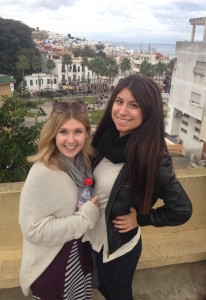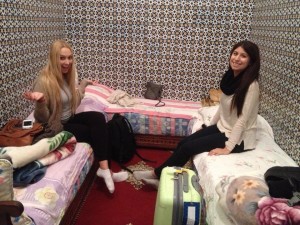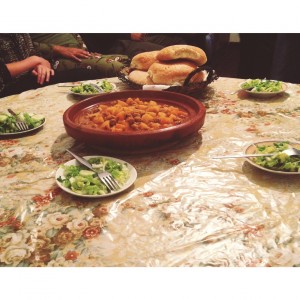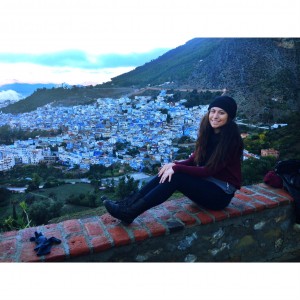Like I said in my introductory post, I’m posting all of these long after I was supposed to (sorry about that). However, after my first day (Saturday night, June 15) I did write down everything that happened as far as getting to Fes, so luckily I can just use that for this particular entry, while adding in a few little details.
Just for context, I was to take a flight from San Francisco to New York, then from New York to Casablanca. Then I would take a train from Casablanca to Fes.
—::—
So, where to begin? I’ve only been in Morocco one day but it feels like it’s been a week since I left. I actually have to struggle to remember everything. So the first flight was from San Francisco to JFK Airport, New York. Had to get up around 4 in the morning on Friday to get to the airport on time and everything. There was some initial confusion since even though I was taking JetBlue airlines from San Francisco to New York, which is a domestic flight, JetBlue was in the international terminal, so I suppose they go by the ultimate destination (Morocco) rather than where I would be changing flights. Luckily, my dad came into the airport with me to help out, and once we figured out where I had to go and I got my ticket, the rest went off without a hitch. I got some sleep, though it wasn’t very good sleep since my neck was uncomfortable, but whatever.
Then there was JFK airport. That place was a nightmare. Just the sheer size of the airport was enough to make my head spin. As I departed the plane, I realized that the ENTIRE TERMINAL I was in was just for JetBlue airlines!! So I had to figure out how to get to the other terminals, which wasn’t easy since it’s such a big airport. I eventually discovered that I had to get on this “airtrain” thing, so I followed the signs until I got to it. Then I had to look up which terminal Air Maroc (my flight to Casablanca) was in (Terminal 1), and then I jumped on the little airport metro thing (sorry, airtrain) and got there okay.
From there though, I had to get my ACTUAL ticket in order to go through security, which wasn’t difficult, and then I just waited in line for a while and got through security. After that, it gets annoying, though. According to my boarding pass the flight was leaving from Gate 9, which I got to just fine. A flight to Brussels was leaving, so I figured my flight to Casablanca would show up on the screen once that was done (there was no single big screen with all the departures and corresponding gates). However, I check back later only to see a flight to WARSAW pop up. I asked the lady at the counter and she didn’t help at all, so I walked over to neighboring Gate 10 just to see if I got lucky, and it turned out the flight was coming in at Gate 10… an hour late. I actually had a bit of a freak out because I wasn’t sure if I was miscalculating military time and had already missed the flight, but no, it was just late. Then there was this huge line that formed, right next to another line for this Air France flight that kept getting all delayed or something. Point is, EVENTUALLY I got on to the plane, although about an hour later than the ticket said we would. From here it gets worse though. The flight itself was fine, the seats were good, there was plenty of leg room, and the pillow allowed me to get some good sleep. BUT, even after everyone boarded, the flight didn’t leave for another two hours! It sat at the gate for the longest time, then it taxi’d a little bit, then stopped, then taxi’d a little bit, and so on. It’s a good thing I told Driss Marjane (the program director for AHA) I would arrive in Fes between 2 and 5!
Once we landed in Casablanca (and just the view from the plane was great, Casablanca is just miles and miles of totally flat farmlands with Moroccan style manors scattered about), I couldn’t find an ATM, so I just exchanged some money at the booth. I followed the signs that featured a picture of a train. Here was another issue: my computer, as well as the little clock on the flight map on the back of everyone’s seats in Air Maroc, said the time was an hour earlier than it actually was. Add to that the fact that everything’s in military time, and I’m not sure what the heck is going on. Getting the two tickets was a breeze, I just mentioned Casavoyageurs, and Casavoyageurs to Fes to the man in the booth, and he instantly understood. He also pointed to the proper dirham bills I needed to pay him with. At this point, I had set my watch to an hour earlier than the actual time without realizing it, so my watch said it was 8:58am or so. My ticket said the train departed at 10:00am, so I figured for some reason I didn’t catch the next one that would leave in a few minutes and had to wait for the one after. However, just to be sure, I went to where the trains stop, and the train there was the same number as the one on my ticket! So I jumped on board and sat in my comfortable first class seat, and promptly moved my watch time forward an hour.
The ride to Casavoyageurs took a half hour, and the scenery was great. Bright red, yellow, orange dirt and rocks, bright green foliage, square buildings in earthen tones. Two American ladies sat down with me, and it turned out they were headed for Fes as well (and were probably on the same airplane, since they said they came from New York). So we just sort of figured out how to get to the Fes train together, and I tagged along with them. Eventually it was figured out where this train was, so it was a good thing I stuck with them, since I assumed it was at a different terminal! This train was much larger than the other one, and it was in the style of European trains with the booths that seat six people and have doors you can shut. Me and the two ladies from New York just sat in one for ourselves, but just like my experience traveling in trains with my parents in Europe, it turned out we were supposed to sit in an assigned compartment. I wound up sitting in a booth with two women speaking Arabic, a little girl, and a silent middle-aged man with a shaved head. The man silently gestured to available places I could put my baggage (since I just set it on my lap at first), and later silently offered me some Pringles (but I didn’t want any salty chips since I was already sweating like a beast, so I passed up the offer). However, once I pulled out my Moroccan phrasebook, he totally surprised me by speaking to me in English! It turned out he didn’t even speak Arabic at all, he was an Englishman who comes to Morocco a few times a year, because he married his wife (who was speaking Arabic with the other woman) here. I think his parents were Pakistani, but he was born in England. He lives in Birmingham, if I recall correctly. He was a really neat guy, the three and a half hour train ride flew by remarkably fast thanks to the interesting conversation. We covered everything, from the experience of traveling abroad to learning Arabic and the Qur’an to the political and social implications of the housing crisis/economic recession. I also learned he planned to open up a moped garage in Morocco sometime in the near future. I think I won the lottery as far as being randomly stuck with someone on a train for three hours!
As an added bonus, another middle-aged man named Hassan joined our booth after one of the stops, and spoke in Arabic to the Englishman’s wife and the other woman. After several minutes of this, suddenly he reveals that he also speaks English, and he’s American! Well, he has dual citizenship. He lived in Richmond Virginia, then moved to the Bronx, then moved (back?) to Morocco. They were all really nice people, the scenery was amazing, and I was almost disappointed when we finally reached Fes. I said goodbye to Hassan (the Moroccan American) and the Englishman (I only heard the Englishman’s name once at the end of the ride, and I have a really bad memory so I’m sorry if I get this wrong, but I think it was Faru), and departed the train. It seems you can meet some really interesting people on the train to Fes.
Once I got out of the train, I was struck by how much hotter it was with the sun beating down at 2:30pm without the cool sea breeze that Casablanca had (Casablanca seriously felt just as comfortable as California during the summer). I was supposed to meet Driss Marjane, the AHA program director, at the train station. I didn’t see Driss, but I figured since my plane was late that he probably had picked up the other two AHA students and was waiting at the hotel. A middle-aged Moroccan man with a sort of bugged-out eye approached me with greetings in Arabic, French, Spanish, and finally English, and since I was getting a little anxious, I decided I would just trust him since he wanted to taxi me to the hotel on foot (since I had the address of the hotel written on a flashcard, and it was only a few blocks away). My gut and my brain told me not to follow this random, shady-looking man into the city by myself, but for some reason I just decided to go with the flow.
I followed the man through the town in the scorching heat, I was sweating up a storm and I was also freaking out a little in my head since it was just me and this shady guide walking down some dilapidated streets. With what little English he knew, he told me how he had a bunch of American friends, and he kept bringing up the fact that he would take me on a tour of the medina and give me discounts for shopping and the like. I think he also implied that he could sell me some hashish, haha. I turned down all of his offers of course, and we finally arrived at the hotel. It had the right name and was across from a massive McDonald’s, just as described in an email from Driss. I got my leftover dirhams (Moroccan currency) out, and since I didn’t know how much to pay someone for walking me to the hotel, I just asked him how much I should give him by holding out the various bills I had. Predictably he wanted me to give him the biggest bill, which was 200 dirhams (a little over 20 American dollars). Obviously that’s more than I was obliged to give him, but he had ultimately brought me to my destination, he carried one of my bags, and I really just didn’t care at this point, so I gave it to him. Before he left he told me his name (Mohamed) and gave me his right hand to shake. Turned out he had a malformed right hand in addition to his bug eye. I still shook his hand though. He was very thankful for the money, probably since he wanted future business (he wrote down his cell number on the back of my flashcard), but at the end of the day, it’s only 20 dollars, and it’ll go to feeding his family anyway (or maybe it’ll go to drugs, who knows). Either way, no point crying over spilled milk I figure. I don’t plan on getting in that kind of situation again, but I met a pretty interesting character as a result.
Now the next challenge. I walked into the hotel lobby with my two bags and realized I had no clue what to do next. After waiting around I went up to the man behind the counter, who did not speak English, and I just sort of desperately mentioned Driss’s name to see if anything happened. When that didn’t work, I figured I’d ask if he had a phone I could use, since I had Driss’s mobile number on the flashcard. He revealed that the phone in the lobby didn’t work, so I would have to go to a payphone up the street. I found the payphone, but had no idea how to work it, or even if it was still working. Even if I did somehow manage to figure out how to put the coins in it, I don’t think I had enough dirhams anyways. I was really starting to freak out at this point, so I made my way back down the street… And that was when this American comes up to me and asks if I’m Mike.
As luck would have it, I walked right by a cafe where the other two AHA students, both from Portland, Cody and Ahmed, were sitting. Cody was the one who came up to me, and man was I happy to see them. I sat down with them and eventually Driss showed up at the café. We shook hands and then he bought lunch for all of us.
Driss took me back to the hotel, got me my room key, and just told me to meet him back down in the lobby at 6pm. So I got an hour and a half to relax after all of the stress and anxiety. Downstairs Driss gave me, Cody and Ahmed our class schedule, a schedule of all the excursions we could go on through ALIF (American Language Institute of Fes) this summer, and a copy of the homestay info he emailed us earlier. We also met Jenna (I never saw how your name was spelled, so again, sorry if I’m doing it wrong!), an AHA employee who was really nice and accompanied us on Driss’s tour of the New Medina (Ville Nouvelle). The rest of the evening was basically just a tour as we all got to know each other. He showed us ALIF, as well as locations of various ATMs, and he gave a lot of general advice that was good to know. Driss is a really awesome guy, he is totally fluent in English AND French, plus he’s funny, smart, and extremely generous and helpful (you can see Driss in the photo of me in my introductory post… he’s standing behind me wearing a green shirt). We ate at a nice Italian place (all the menu items were in French, so I was lost, but it wasn’t any worse than when I was in Europe with my parents), and then finally we arrived back home after buying some bottled water.
—::—
Aaaaaand end quote. Actually it seems I lied in my introductory post, I don’t think I will be able to recount the first week’s events before today (Monday, June 24) ends, as I will only have internet access for the next thirty minutes or so, and I need to use that time to do Arabic homework. Looking back on it, I think I will probably split my first week in Morocco into two or three blog posts, just because there is so much material, and that way I can put SOMETHING on this blog (inshallah) rather than waiting and then just dropping one really big post.
Just because of everything going on during my arrival, and trying to acclimatize to my new surroundings, I didn’t take any pictures. However, I will have a LOT of pictures to share in the coming posts… I’ll leave you with this tantalizing taste of things to come, a preview of sorts… Peer into the gate now, then explore what lies beyond in the next installment of this blog!
Michael























































